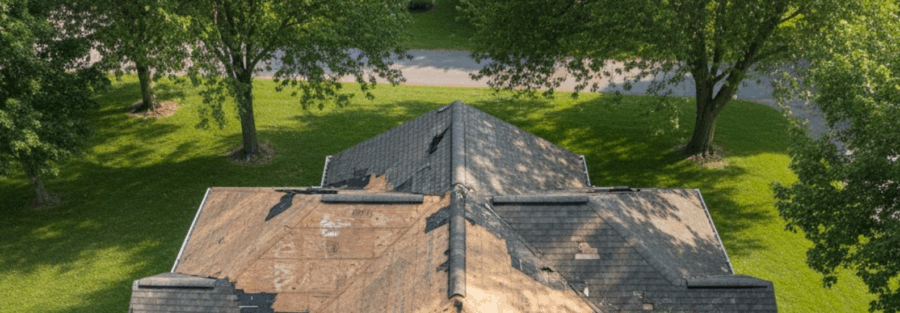When curling shingles, recurring leaks, or multiple existing layers signal trouble, the tear-off roof process may be your best solution. This comprehensive approach strips everything down to the decking, addresses hidden damage, and establishes a proper roofing system from the ground up. The tear-off roof process delivers superior results, maintains manufacturer warranties, and offers critical protection—particularly valuable for DFW Texas properties facing severe weather conditions. From initial assessment through final installation, we’ll guide you through each phase while safeguarding your property and landscape. Our team is on call to evaluate storm damage and begin restoration immediately, ensuring your home or business stays protected.
When A Tear-Off Roof Makes Sense
A full tear-off is the right move when your home has more than one shingle layer, the decking might be compromised, or you want full manufacturer warranty coverage on your new roof. Building codes across North Texas commonly limit the number of layers, and for good reason: multiple layers can trap heat and moisture. The tear-off roof process lets us inspect the deck, correct hidden issues, and install materials to spec.
Here are clear signals a tear-off is your best option:
- Two or more shingle layers, or code requires removal before replacement.
- Soft spots, sagging areas, or persistent leaks hinting at deck damage.
- Hail, wind, or tree impact that likely affected the substrate.
- You’re switching materials (e.g., from three-tab to architectural shingles) and want a proper base.
If storms have recently rolled through DFW, a tear-off gives us a clean slate to repair and restore for long-term performance. It’s a smart, once-and-done approach.
Have questions about whether a full tear-off is right for you? Explore our roofing services and contact us for a free inspection.

Planning, Permits, And Home Preparation
A smooth project starts with thoughtful planning. We coordinate permits, materials, and debris logistics before the first shingle comes off. This is also when we protect your property, covering plants, moving patio furniture, and staging equipment so the crew can work quickly and safely. The tear-off roof process is detailed, but careful prep keeps your day-to-day life on track.
Scope, Codes, And Permitting
We define the scope after a thorough inspection, noting layers, flashing needs, ventilation upgrades, and any deck repairs. Then we secure the necessary permits and ensure the plan aligns with municipal codes and manufacturer specs. In DFW Texas, code compliance is key to warranty validity and resale peace of mind, another reason the tear-off roof process is worth doing right.
Scheduling, Materials, And Dumpster Logistics
We coordinate delivery of shingles, underlayment, flashing, and ventilation components to match the start date. Dumpsters arrive just in time to keep debris moving offsite. We set a staging area for new materials and a safe, contained route for tear-off debris, which keeps the site tidy and the work flowing.
Protecting Landscaping And Notifying Neighbors
Before we start, we drape tarps over landscaping, set up plywood shields where needed, and brief the crew on “no-drop” zones. We’ll also give your neighbors a heads-up about timing and noise so there are no surprises.
Tear-Off And Deck Repair: Step By Step

This is where the action happens. We remove old materials methodically, expose the deck, and address any issues we find. The tear-off roof process helps prevent “cover-up” repairs and sets the stage for a roof that lasts.
Safety Protocols And Required Tools
Safety comes first. Our crews use fall protection, proper footwear, stable ladders, and harness tie-offs. Tools include roofing shovels for shingles, pry bars for flashings, magnetic sweepers, and cutting tools. We secure access points and maintain clean walkways throughout.
Removing Shingles, Underlayment, And Flashings
We start at the ridge and work down-slope. Shingles, nails, felt or synthetic underlayment, and all old flashing are removed. Gutters are cleared as we go, and debris is routed directly to the dumpster to keep your property tidy, an important part of the tear-off roof process.
Identifying And Repairing Decking And Framing Issues
With the deck fully exposed, we inspect for rot, delamination, and fastener pull-throughs. Any compromised sheathing is replaced, and framing concerns (like split rafters or sagging sections) are addressed. This is the moment to fix the substrate so the new system performs as designed.
Handling Valleys, Chimneys, And Penetrations
We pay special attention to valleys, skylights, plumbing stacks, and chimneys. All flashings are renewed, surfaces are prepped, and any past leak paths are eliminated before we move on.
Weatherproofing: Underlayment, Flashing, And Ventilation

With a sound deck, we rebuild the roof’s weather defenses. This phase determines how well your system stands up to DFW’s wind, downpours, and heat. The tear-off roof process ensures every layer, underlayment, flashing, and vents, works in sync.
Ice And Water Shield, Drip Edge, And Starter Courses
We install ice and water shield in leak-prone spots like valleys, eaves, and around penetrations. Drip edge locks the perimeter, and starter strips set the bond line at the eaves and rakes for wind resistance.
Step Flashing, Counterflashing, And Sealants
At walls and chimneys, we integrate new step flashing with counterflashing for layered, code-compliant protection. We use high-quality sealants as a complement, not a crutch, so the details shed water naturally.
Intake And Exhaust Ventilation Best Practices
Balanced ventilation matters in Texas heat. We pair soffit intake with ridge or roof exhaust to meet code and manufacturer requirements, helping reduce attic heat, prevent moisture buildup, and extend shingle life.
Installing The New Roof And Cleanup

Now the new surface goes on, and the site gets buttoned up. In DFW, precise installation plus meticulous cleanup is the difference between a great experience and a stressful one. The tear-off roof process is only complete when your property looks better than we found it.
Shingle, Metal, Or Tile Installation Essentials
We install your chosen material per manufacturer specs, course alignment, staggered seams, and correct exposure. Under high-wind considerations, we use enhanced fastening and sealant placement as required.
Fastening Patterns, Ridges, And Hip Caps
We follow specified nail counts, placement, and penetration depth. Ridges and hips are capped with compatible components for a clean finish and continuous ventilation where designed.
Jobsite Cleanup, Magnetic Nail Sweep, And Final Walkthrough
Throughout the day, debris is removed and tarps cleared. We run magnetic sweepers around driveways, walkways, and planting beds, then clean gutters again. Finally, we conduct a walkthrough with you, confirm warranty documentation, and share maintenance tips.
Costs, Timeline, And Hiring A Contractor
Budget and timing are influenced by your roof’s size, accessibility, material choice, and the extent of deck repairs. We’re transparent about line items and keep you informed if site conditions change during the tear-off roof process.
Key Cost Drivers And Budget Ranges
Major drivers include: number of shingle layers to remove, debris disposal, deck repair needs, flashing and ventilation upgrades, and your selected roofing material. Architectural shingles are popular in Texas for durability and curb appeal, and they pair well with code-required ventilation updates.
Project Duration And Weather Considerations
Typical DFW timelines run a few days for many homes, longer for complex roofs or major deck repairs. We actively monitor weather: if storms threaten, we secure the deck with underlayment and tarps so your home stays protected.
How To Vet Contractors, Contracts, And Warranties
Choose a licensed and insured roofer with local references and clear, written scopes. The contract should spell out tear-off steps, materials, ventilation, flashing details, cleanup, and warranty coverage.
Conclusion
A solid roofing project starts with a clean slate. Following the tear-off roof process, down to the deck, repair, and rebuild, you get a stronger, code-compliant system built for DFW Texas weather. And if you’re planning future solar, a proper tear-off ensures the roof beneath your panels is ready for the long haul.
Alpine Roofing is your trusted roofing company in DFW Texas. We’re located at 7247 Kentish Dr, Fort Worth, TX 76137. For inquiries, call us at +1 682-257-4631 or email info@alpineroofingandsolar.com.
Want a detailed, line-by-line estimate from a DFW roofing expert? Contact us anytime. We’re available 24/7 for emergency assessments, storm restoration, and full replacements.
Frequently Asked Questions
What is the tear-off roof process, and why is it recommended in DFW Texas?
The tear-off roof process removes all roofing layers down to the bare deck, repairs any damaged sheathing or framing, and rebuilds the system to code and manufacturer specs. In DFW, it’s preferred for storm resilience, code compliance, and full warranty eligibility, especially when multiple layers or hidden deck issues are present.
What are the main steps in the tear-off roof process?
A proper tear-off includes planning and permits, property protection, systematic removal of shingles, underlayment, and flashings, full deck inspection and repairs, weatherproofing with underlayment, drip edge, and new flashing, balanced ventilation, installing the new roof material, and meticulous cleanup with a magnetic nail sweep and final walkthrough.
How long does a tear-off roof replacement take in DFW, and what if it rains?
Most DFW tear-off roof projects finish in 1–3 days, depending on roof size, complexity, and deck repairs. Crews monitor weather and, if storms threaten, secure the deck with underlayment and tarps to keep the home protected until installation resumes under safe, dry conditions.
What factors affect the cost of a tear-off roof?
Key cost drivers include the number of layers to remove, debris disposal, deck repair needs, flashing and ventilation upgrades, roof complexity and accessibility, and the chosen material (e.g., architectural shingles, metal, tile). Transparent scopes and change-order processes help manage budget as site conditions are uncovered.
Is a roof overlay cheaper than a tear-off, and which lasts longer?
An overlay usually costs less upfront because it skips removal and disposal. However, it can trap heat and moisture, may violate local layer limits, and can void or limit warranties. A full tear-off roof process provides a clean deck, corrects hidden problems, and typically delivers better performance and longevity.
Will homeowner’s insurance cover a tear-off after storm damage in Texas?
Often yes, if damage is from a covered peril like wind or hail. Insurers typically require documentation: a professional inspection, photos, and a detailed scope. Wear and tear or pre-existing issues aren’t covered. Mitigate further damage promptly (e.g., tarping) and file your claim quickly to stay compliant with policy timelines.




